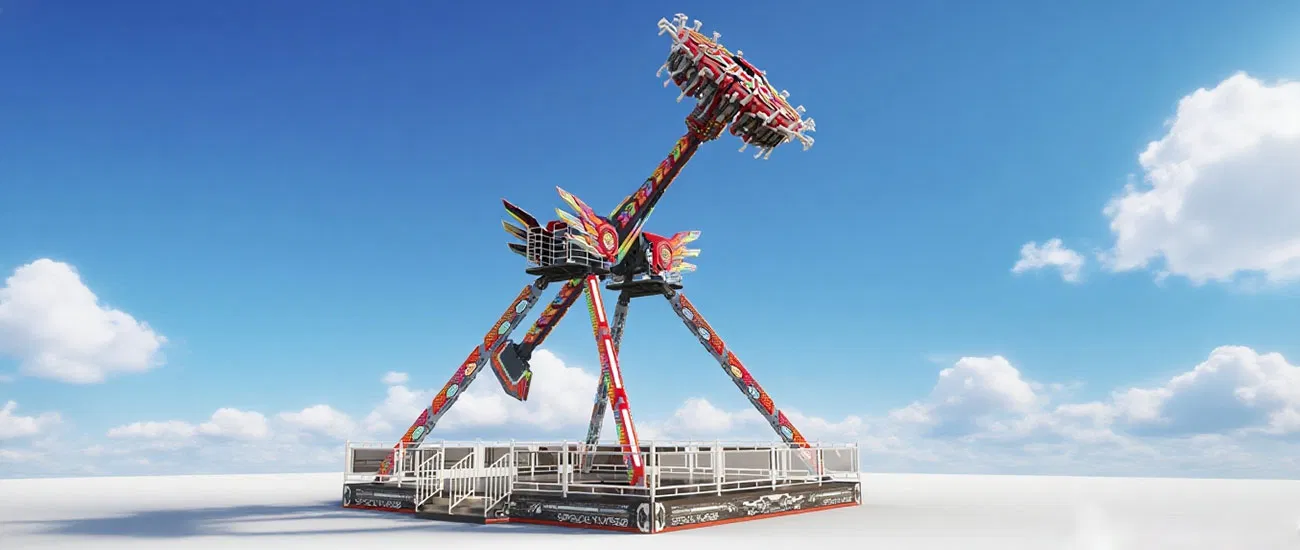The evolution of amusement parks has transcended beyond mere entertainment; it has entered the realm of experiential branding, where attractions serve as both leisure and social media catalysts. Among emerging trends, the “internet celebrity check-in” ride represents a paradigm shift, blending traditional amusement engineering with digital culture. These rides are designed not solely for thrill but also for capturing shareable moments, optimizing visibility in a hyperconnected society.
Conceptualizing the Digital-First Fairground Ride
The design of an internet celebrity check-in ride begins with a dual mandate: the attraction must deliver a compelling physical experience while simultaneously accommodating photogenic or video-friendly moments. Modern visitors increasingly prioritize Instagrammable aesthetics, meaning visual elements—lighting, color schemes, and dynamic motion—must be meticulously orchestrated.
Fairground rides intended for this purpose require integration of both kinetic appeal and visual spectacle. For example, pendulum rides, traditionally valued for their high arc and centrifugal forces, offer an ideal platform. Their oscillatory motion not only delivers adrenaline but also provides visually dramatic footage, particularly when synchronized with lighting effects or digital augmentation.

Engineering Thrills with Market-Ready Solutions
Amusement rides companies face a challenging task: translating these immersive concepts into commercially viable installations. Designers must balance structural integrity, ride mechanics, and guest throughput while remaining attuned to the aesthetic and social demands of contemporary consumers. Selecting a drop tower ride for sale, for instance, is not simply a matter of height or speed; the unit must facilitate staged photo opportunities and feature elements that enhance the spectacle, such as transparent gondolas or panoramic views.

Furthermore, engineering considerations extend to material selection and motion control. Pendulum rides and drop tower rides both impose significant mechanical stress on support structures and restraint systems. Advanced sensors and predictive maintenance protocols are often employed to ensure consistent operation, safeguarding both ride longevity and guest safety.
Spatial Dynamics and Guest Flow
The placement and design of internet celebrity check-in rides require careful spatial planning. Optimal configurations maximize visibility from multiple vantage points and encourage organic social media interaction. Strategic sightlines, dynamic queuing arrangements, and interactive pre-ride zones can cultivate anticipation while providing guests with multiple opportunities for staged content creation.
Theming plays a crucial role as well. Environments that complement the ride’s kinetic features can elevate the experience from mere thrill to immersive spectacle. For example, pendulum rides positioned over illuminated reflective surfaces or interactive projections enhance visual appeal, while drop tower ride for sale models outfitted with LED lighting sequences can transform standard ascents into photogenic high points.

Operational Considerations
Operational strategies for these rides differ from traditional amusement installations. Amusement rides companies increasingly emphasize throughput efficiency and digital engagement metrics. Ride cycles may be slightly adjusted to allow passengers to capture optimal footage without compromising safety or operational capacity. Queue design often incorporates staging areas with integrated cameras or augmented reality experiences, ensuring that each rider’s experience can be documented and shared seamlessly.
The integration of digital platforms also necessitates robust infrastructure. Wi-Fi-enabled zones, high-contrast lighting, and unobstructed camera angles allow guests to broadcast live or capture high-quality content. Additionally, maintenance schedules must consider the increased intensity of visual components such as LED panels and augmented reality projectors, ensuring consistent presentation without unexpected downtime.
Marketing and Social Amplification
The success of internet celebrity check-in rides hinges on social amplification. Marketing teams collaborate with designers to ensure that every physical feature of the ride can double as a shareable moment. Pendulum rides, with their soaring arcs, often become natural backdrops for slow-motion video content, while drop tower ride for sale installations capitalize on the dramatic reveal at the apex of the ascent. By creating rides that are simultaneously thrilling and visually compelling, parks cultivate organic promotion through user-generated content.
Moreover, the “check-in” concept encourages repeat visitation. Guests seeking to capture unique angles or seasonal variations are motivated to return, creating recurring engagement and long-term brand visibility. This dynamic introduces an intersection of operational design, social psychology, and digital marketing, where ride mechanics serve both experiential and promotional functions.
Safety and Regulatory Compliance
While aesthetic and digital considerations are paramount, safety remains the foundation. Fairground rides must comply with rigorous engineering standards, including structural load testing, dynamic motion analysis, and emergency response protocols. Drop tower ride for sale and pendulum rides undergo repeated stress simulations to prevent fatigue failures, while restraint systems are engineered for both comfort and security during extreme motion sequences. Regulatory frameworks require detailed documentation, inspections, and certifications before public operation, underscoring the critical balance between spectacle and safety.

Future Trends
As amusement parks increasingly embrace digital culture, the design of internet celebrity check-in rides is poised for further innovation. Integration of real-time interactive features, AI-powered photography, and immersive augmented reality can elevate the ride experience to unprecedented levels. Collaboration between engineers, creative directors, and amusement rides companies ensures that these installations remain both technically feasible and socially compelling, bridging the gap between mechanical ingenuity and cultural resonance.
Emerging trends also suggest a hybridization of ride formats. Combining pendulum rides with rotating platforms, or drop tower rides with virtual reality overlays, creates multi-sensory experiences that cater simultaneously to thrill-seekers and content creators. In this context, the “internet celebrity check-in” ride evolves from a niche marketing strategy into a core design principle for modern amusement attractions.
Conclusion
The design of internet celebrity check-in rides represents a convergence of engineering precision, aesthetic sophistication, and social media awareness. Fairground rides, whether pendulum rides or drop tower ride for sale models, are no longer judged solely by their thrill factor; their capacity to generate visually compelling experiences has become equally vital. Amusement rides companies are navigating this complex landscape by integrating technological innovation, structural reliability, and digital marketing insight, ensuring that each installation resonates with both physical and virtual audiences. As amusement parks continue to evolve, the rides themselves will increasingly serve as platforms for social interaction, digital storytelling, and unforgettable experiential design.